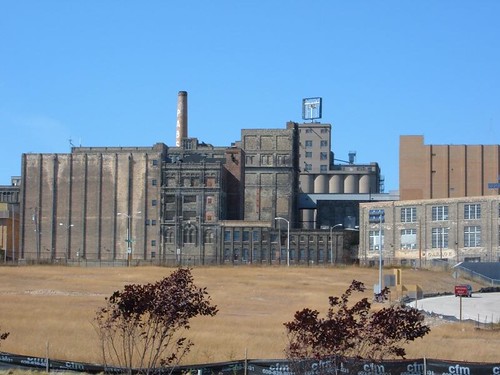
Pabst Brewery from the east, October 2004.
I've seen it happen several times in St. Louis and Milwaukee: a massive complex of buildings, built up and added onto over many decades, is abandoned, decays for a while, becomes an urban explorer's paradise, finally gets bought up, is partially demolished, and winds up redeveloped.
It's that "partially demolished" bit that always brings me down.
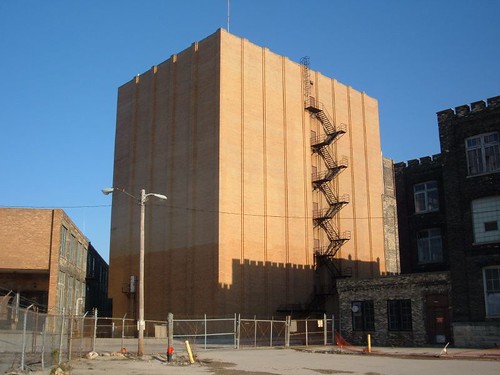
Building 3
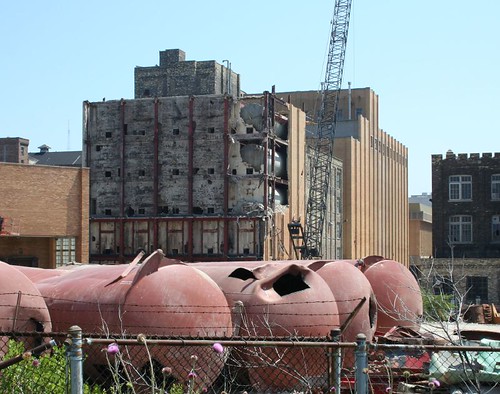
Building 3 under demolition
I've never worked on the design of such a complex, so it's hard to say just what is and isn't always possible. Certainly there are times when one building needs to come out so that light can reach the windows of its neighbor. Sometimes remediation is simply prohibitively difficult. And of course decay takes a toll on abandoned structures, and not everything can be saved.
But it seems like, inevitably, the final result is to thin out and water down some of what makes such complexes so fascinating, which is their delightfully jumbled massing. A place like the Gallun Tannery or Pabst Brewery is a visual pile of buildings on top of buildings on top of still more buildings, scrambled up and accumulated piecemeal over a long and complex history. They have the density that cities need built right into their very structure. They are frantic masses of architecture, laden with secret corners and hidden delight.
But the first thing developers do is to come in and start knocking things down -- tearing away at the very thing that makes the complex so compelling.
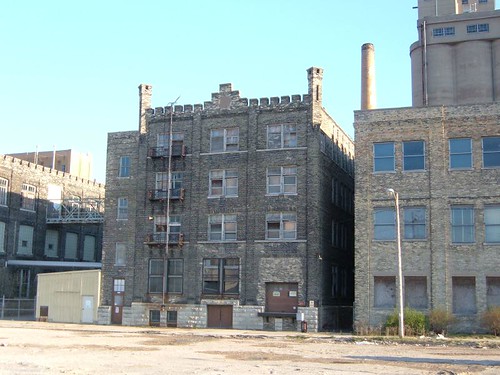
Building 11
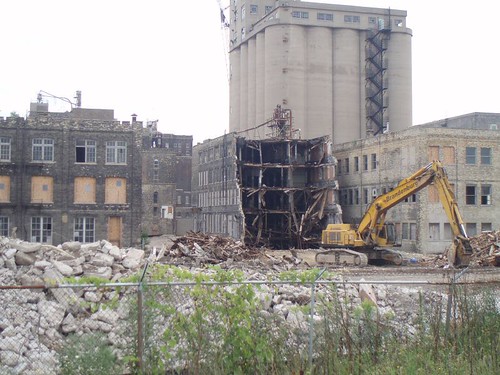
Building 11 under demolition
There's a loss of history and architecture, too. Building 11 at the Pabst Brewery was of the same age and architectural style as the historic buildings that are to remain, and had nicer crenellation details than many of the survivors.
Purely functional accretions are frequently swept away, too, removing the gritty industrial nature of places like Pabst. Pipes, ducts, and non-architectural structures are removed as a standard part of sanitizing a complex, seemingly with no thought given to how they might be reused and incorporated into the renovation.

Jungle gym, vine-covered trellis, multi-colored sculpture, surreal pagoda, scenic overlook, straightforward monument to industrial history -- there are innumerable possibilities for such a construct, if one looks beyond the norm.
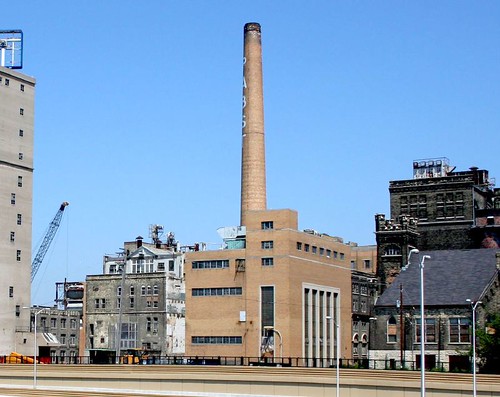
Power Plant

Power Plant under demolition
But we live in a culture that strives to sanitize, to the point that simply taking on the challenge of renovating a historic complex is already going far out on a limb. To leave it looking something like the aged industrial complex that it actually is? Outrageous! Out of the question!
However, much to the credit of the developers behind The Brewery, Building 20 will apparently retain its multi-story atrium and the enormous brew kettles within.
Even more impressive, the grain elevators -- described on the site as iconic -- will be retained, and are advertised as a potential location for an elevated restaurant or similar facility. That's exactly the sort of creative thinking needed for a site like this -- not just on a macro scale, but also carried down to the fine details.
6 comments:
Dont use "flickr" for photo hosting. DUH!!!
Flickr rocks. The error was my own, not theirs. No apologies!
Don't praise the developers for keeping the brew kettles and the grain elevators. They've turned the history of the complex into a gimmick and don't actually care about the significance this complex had in the development of the city of Milwaukee. They don't even list the project as a historic on their website - its a mixed use redevelopment. Creativity didn't save the power plant or a number of other buildings that were razed - buildings that could have been converted into something if the company thought about anything other than profit
and turning a once beautiful complex into yet another generic mixed-use strip mall. The development of this site is just another classic example of the ignorance of the city's urban development overall. They let Marquette all but eradicate Wisconsin Avenue's 80 some mansions in the 1970s for a lovely collection of modern atrocities and let the "Fifth Ward" become a new hot spot for development, while the historic district of Walker's Point only a few blocks away essentially rots. It's tragic, because one of the greatest assets of this city is the rich history that remains, but unfortunately more than a few are too willing to throw it all in the name of profit.
I apologize for the rant. I've been working on a research project on the brewery and the impact of economics on the impact of architectural development in America and I get a little feisty because historic preservation is my passion. I appreciate that you brought attention to this issue and I actually saw the post last spring while working on another project on Walker's Point. Knowing that there are others who care about America's historical heritage is very refreshing, particularly in this day and age.
I actually currently live in the old keg warehouse of the Pabst. My loft and this whole development are turning out to be rather nice. Better to use the complex rather than just let it sit.
You sir have every opportunity and buy one of these buildings ( they are inexpensive) And develop these Buildings as you see best serves the community. In the meantime there are persons whom have invested there own person wealth to begin a long and expensive rehab of these buildings that would otherwise be in total ruin due to Pabst leaving the buildings without winterization and preventative maintenance.
The problem I have with these places is that once they are ruined, I mean redeveloped, nobody can go and admire the buildings. Try going up to the remaining Schlitz or Pfister and Vogel complex and see what happens. A few summers ago I tried to go take pictures of the few remaining Schlitz buildings and immediately was approached by some rent a cop and was told to leave or else the cops would be called... hmmm. That's awesome, thanks for letting us Milwaukee folk who are interested in it's rich history explore what little we have left. I wasn't breaking into any buildings, just taking photos. Yeah it's great that these awesome people with deep pockets are buying these buildings but you either need to pay 1 million dollars a month to live in the condo or work in the cube farm that now reside in these once proud buildings to get any sort of a view of them. Your only other option is to stand on the sidewalk 1000 feet away and take photos from a distance. Oh wait.... I tried that too only to have the security guard at the P&F complex circle me a dozen times and then stop to stare at me like I had 100 pounds of TNT strapped to my chest.
Post a Comment